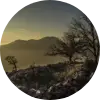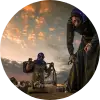
















Kurşunlu Mosque (Fatih Pasha Mosque)
General Information: Fatih Pasha Mosque is a historic mosque located in Diyarbakır, Turkey. It was commissioned by Bıyıklı Mehmed Pasha, the first Ottoman Governor of the city, and built between 1516 and 1520. Considered the largest and most elaborate among the structures in Diyarbakır, it is also known as "Kurşunlu Mosque" due to its dome and roof being entirely covered with lead.
Location and Surroundings: The mosque is situated in the northeast of the city, in Fatih Pasha Neighborhood, on İç Sokak. It was constructed by Bıyıklı Mehmed Pasha after the Ottomans conquered Diyarbakır. Surrounding the mosque are ruins of structures that may have once been a madrasa and a bathhouse, while in front of it stands a complex including the tomb of Bıyıklı Mehmed Pasha and other buildings.
History: Fatih Pasha Mosque was built between 1516 and 1520. In 1991, it was registered and protected by the Diyarbakır Cultural and Natural Heritage Conservation Regional Board under the name "Kurşunlu Mosque and Cemetery". The mosque underwent several renovations throughout its history. However, it suffered significant damage and fire during clashes between the PKK and Turkish security forces in December 2015. After repairs were completed on March 7, 2019, following the restoration, the mosque reopened for worship.
Architectural Features: The mosque follows a central plan scheme. The enlargement of the main dome with half-domes on four sides was achieved using pendentives. To the north of the prayer hall, there is a seven-dome portico supported by white marble columns. One of the most notable features inside the mosque is the mihrab (prayer niche) and the minbar (pulpit) on the qibla wall. The mihrab is made of finely cut limestone, while the minbar is marble and intricately decorated. The mosque's minaret has a single balcony and is adorned with six rows of muqarnas.
Inscriptions and Decorations: Unfortunately, the construction inscription of the mosque has not survived to this day. However, it is mentioned that there was a construction inscription above the entrance gate to the courtyard, which was destroyed and lost during uprisings in Diyarbakır in 1819. The mosque features decorations on stone and wood surfaces, employing carving, relief, and cage carving techniques on basalt, limestone, and marble.
Complex: To the northwest of the mosque lies a tomb, and to the northeast is the tomb of Özdemiroğlu Osman Pasha, an Ottoman governor from the 16th century. Additionally, the Şafiîler section, dating back to the second half of the 16th century and formerly used as a madrasa, has been serving as the Fatih Pasha Women and Children's Education Center since 2004.
This historic mosque and its complex stand as one of the cultural and historical treasures of Diyarbakır, under significant protection.